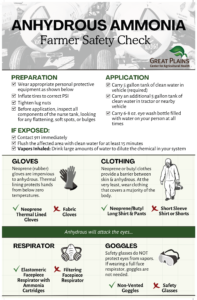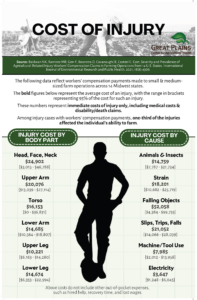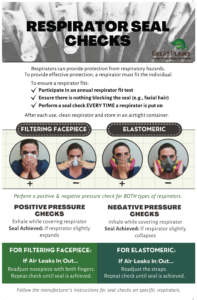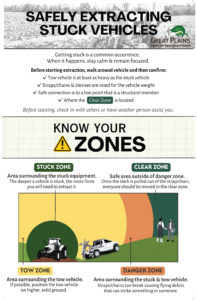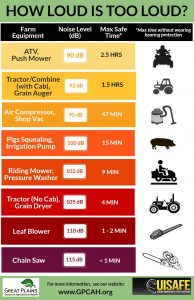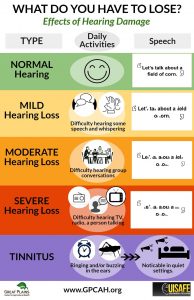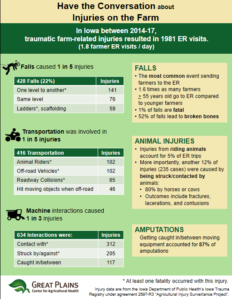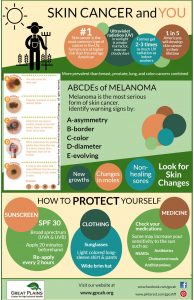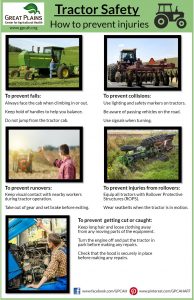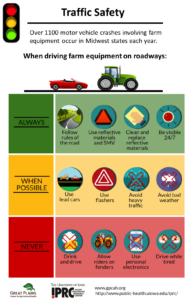Ag Health and Safety Posters
Since 2017, GPCAH has provided free posters and information to Ag Educators throughout the Midwest to assist with educating ag students about health and safety risks and prevention.
2025 UPDATE! We have updated this page with seven new posters, suitable for using in the classroom or on the farm.
Click on the titles below to obtain details and publications related to the top. If you click on the poster image, you will find a full-scale poster pdf, suitable for printing on 11×17 paper.
For co-branding these posters, you can place your organization’s logo over the Iowa College of Public Health logo.
CONTACT US with questions or additional topics of interest.
Air Quality & Gas Exposures
This poster presents a detailed overview of air quality hazards in livestock and grain production, categorizing them by source and type. In livestock environments, significant risks include methane and ammonia emissions from manure handling systems such as slatted floors, lagoons, pits, and tanks—especially when manure is foaming—along with gases produced by animals and combustion byproducts from gas-fired heaters. Grain production hazards include toxic gas emissions from out-of-condition grain, gas-fired dryers, overheating equipment, and silos containing fermenting silage, which can produce dangerous gases like carbon monoxide, nitrogen dioxide, carbon dioxide, and hydrogen sulfide.
Beyond gases, the poster also highlights non-gas hazards such as dust, endotoxins, animal handling risks, and the dangers of grain engulfment and dust explosions. Health impacts from these exposures range from eye and lung irritation to paralysis, respiratory damage, reduced mental function, and death. To mitigate these risks, the poster stresses the importance of properly using and maintaining gas monitors and refers to a FarmSafe podcast episode for further guidance. The message underscores the need for proactive safety practices in managing air quality hazards across agricultural operations.
How to Use in Class
- Share when discussing livestock production and grain bin operations.
- Incorporate into safety and health discussions on inhaled gases or gas monitor use.
Additional Resources
- FarmSafe podcast episode, Gas Monitors, to learn more about how to use, store, & bump test gas monitors: https://gpcah.public-health.uiowa.edu/gas-monitors/
- Ag Health 101 audio unit from which the information in this poster was pulled (Unit 5. Air Quality & Gas Exposures on the Farm): https://gpcah.public-health.uiowa.edu/aghealth101_airquality/
- Ag Health 101 unit summary pages with additional information on air quality and gas exposures on the farm (Unit 5. Air Quality & Gas Exposures on the Farm): https://gpcah.public-health.uiowa.edu/wp-content/uploads/2024/10/Unit-5_Air-Quality_Oct24.pdf
Click here for a printable 8.5×11 version of the Air Quality & Gas Exposures poster.
Center of Gravity: Tractors
This poster explains how the center of gravity (CG) affects tractor stability, particularly when carrying loads, using three illustrated scenarios: unloaded, rear-loaded, and front-loaded. In the unloaded state, the tractor’s CG is centrally located between the axles, ensuring stability as long as it stays within the wheelbase. When a counterweight is added to the rear, the CG shifts backward, increasing rear stability but reducing side-to-side (lateral) stability. Conversely, carrying a load at the front shifts the CG forward; if it moves beyond the front axle, the tractor becomes dangerously unstable and prone to tipping. The poster emphasizes that maintaining the CG within the wheelbase—regardless of load placement—is essential for safe operation. It warns that front-loaded tractors are more susceptible to tipping and require extra caution. Rear counterweights can help balance loads but may compromise lateral stability. Ultimately, if the CG falls outside the wheelbase in any direction, the tractor is at high risk of rollover.
The poster concludes by promoting safe tractor practices and references a FarmSafe podcast episode on Roll-Over Protective Structures (ROPS) for further education.
How to Use in Class
- Display when conducting tractor operation training
- Use as a refresher before moving loads during a new season
Additional Resources
- FarmSafe podcast episode, Safe Tractor Operation: ROPS, provides more information on preventing tractor roll-overs: https://gpcah.public-health.uiowa.edu/tractor-safety-rops/
- Ag Health 101 unit from which the information in this poster was pulled (Unit 10. Tractor Safety): https://gpcah.public-health.uiowa.edu/aghealth101_tractors/
- Ag Health 101 unit summary pages with additional information on tractor safety (Unit 10. Tractor Safety): https://gpcah.public-health.uiowa.edu/wp-content/uploads/2024/07/Unit-10_TractorSafety_Jun24.pdf
Click here for a printable 8.5×11 version of the Center of Gravity: Tractors poster.
Confined Space Safety: Grain Storage Structures
This poster outlines essential safety procedures for entering grain storage structures, emphasizing thorough preparation, hazard assessment, and continuous oversight. Before entering a grain bin, workers must clearly define the task and consider safer alternatives. Proper preparation includes assembling the required tools, personal protective equipment (PPE), and designating a trained entrant and observer. A completed and signed entry permit or safety checklist is mandatory. Entry is only allowed when all pre-entry steps are followed, the observer stays outside with constant visual and verbal communication with the entrant, and is equipped to call 911 if needed.
To ensure safety, all grain handling equipment and power sources must be completely shut off, locked out, and tagged out. Air quality must be tested before and during entry—oxygen levels must remain between 19.5% and 23.5%, carbon monoxide must not exceed 25 ppm, hydrogen sulfide must be undetectable, and dust levels must allow at least five feet of visibility. Structural safety is also critical; if grain is bridged, uneven, or if walls or the floor slope inward, a body harness properly secured to the structure is required.
The poster concludes by encouraging continued education through the FarmSafe Podcast episode “Grain Bin Safety, Part 1: Motivation and Tips to Prevent Engulfment,” which provides further guidance on precautions and PPE.
How to Use in Class
- Use with resources below to walk through steps to ensure safe operation around/in grain bins
Additional Resources
- FarmSafe podcast episode, Grain Bin Safety, Part 1: Motivation & Tips to Prevent Engulfment, provides information on precautions & PPE needed before entering a bin: https://gpcah.public-health.uiowa.edu/grain-bin-safety-pt-1/
- Ag Health 101 unit from which the information in this poster was pulled (Unit 6. Confined Spaces): https://gpcah.public-health.uiowa.edu/aghealth101_confinedspaces/
- Ag Health 101 unit summary pages with additional information on confined space safety (Unit 6. Confined Spaces): https://gpcah.public-health.uiowa.edu/wp-content/uploads/2024/09/Unit-6_Confined-Spaces_Sept24.pdf
Click here for a printable 8.5×11 version of the Confined Space Safety: Grain Storage Structures poster.
Confined Space Safety: Manure Storage
This poster provides vital safety procedures for entering manure storage structures, emphasizing the importance of thorough risk assessment and strict adherence to safety protocols before entry. Entry is only allowed after the task is clearly defined, all alternative methods are considered, and the system is confirmed to be fully de-energized. This includes shutting down and locking out all machinery and agitation or pumping equipment. The ventilation system must be inspected and functioning to ensure maximum airflow.
Key pre-entry steps include identifying structural and atmospheric hazards, verifying adequate ventilation, establishing clear communication between the entrant and an outside observer, and ensuring the observer is trained, properly equipped, and remains outside the pit at all times. A written entry permit or checklist must be completed to confirm that all safety measures are in place.
The poster stresses the importance of preventing exposure to hazardous gases in manure storage and encourages further learning through additional manure gas safety resources.
How to Use in Class
- Use with resources below to have conversations about manure handling safety
- Use when introducing students to livestock operatations to ensure understanding of gas hazards in manure storage areas
Additional Resources
- FarmSafe podcast episode, Manure Gas Safety, with information on hazardous gases associated with manure: https://gpcah.public-health.uiowa.edu/manure-gas-safety/
- Ag Health 101 unit from which the information in this poster was pulled (Unit 6. Confined Spaces): https://gpcah.public-health.uiowa.edu/aghealth101_confinedspaces/
- Ag Health 101 unit summary pages with additional information on confined space safety (Unit 6. Confined Spaces): https://gpcah.public-health.uiowa.edu/wp-content/uploads/2024/09/Unit-6_Confined-Spaces_Sept24.pdf
Click here for a printable 8.5×11 version of the Confined Space Safety: Manure Storage poster.
Fall Risks on the Farm
This poster provides a practical guide to preventing falls on farms by identifying common hazards and offering targeted safety strategies. It emphasizes the importance of maintaining clean, stable working surfaces and using proper equipment to reduce the risk of injury.
The poster also recommends listening to the podcast episode “Falls on Ice” for more winter-specific fall prevention advice.
How to Use in Class
- Use as a reminder prior to site visits, before conducting new tasks on a farm, or to discuss injury prevention, in general
- Use with audible sources, below, for complete coversations
Additional Resources
- FarmSafe podcast episode, Falls on Ice, with tips to prevent wintertime falls: https://gpcah.public-health.uiowa.edu/falls-on-ice/
- Ag Health 101 unit from which the information in this poster was pulled (Unit 9. Falls on Farms): https://gpcah.public-health.uiowa.edu/aghealth101_falls-on-farms/
- Ag Health 101 unit summary pages with additional information on preventing falls on farms (Unit 9. Falls on Farms): https://gpcah.public-health.uiowa.edu/wp-content/uploads/2024/06/Unit-9_Falls_Jun2024.pdf
Click here for a printable 8.5×11 version of the Fall Risks on the Farm poster.
Preventing Pesticide Drift
This poster outlines essential guidelines for preventing pesticide drift, a common issue in agricultural spraying that can affect neighboring crops, animals, and the environment.
Applicators are urged to monitor wind speed, temperature, humidity, and buffer distances to ensure effective pesticide use while minimizing unintended exposure to non-target areas. The poster concludes by recommending that users always consult individual pesticide labels for specific instructions and explore additional resources to compare application technologies, such as boom sprayers versus drones.
How to Use in Class
- Incorporate in lessons on pesticide safety and application planning activities
- Discuss with tools used to understand where to access important meterological information relevant to farming
- Incorporate with audio lessons in resources, below
Additional Resources
- FarmSafe podcast episode, Pesticide Application Technology: Drones vs Boom, discusses the differences in pesticide aerosols & drift when using different application methods: https://gpcah.public-health.uiowa.edu/drones-vs-boom/
- Ag Health 101 unit from which the information in this poster was pulled (Unit 8. Pesticides): https://gpcah.public-health.uiowa.edu/aghealth101_pesticides/
- Ag Health 101 unit summary pages with additional information on pesticide safety (Unit 8. Pesticides): https://gpcah.public-health.uiowa.edu/wp-content/uploads/2024/09/Unit-8_Pesticides_Sept24.pdf
-
Click here for a printable 8.5×11 version of the Preventing Pesticide Drift poster.
Respirator Protection Selection
This poster offers comprehensive guidance on selecting the correct respirator for agricultural workers, emphasizing the importance of matching respiratory protection to specific hazards and work environments. It distinguishes between air-purifying respirators and supplied-air respirators, outlining when each type is appropriate.
Respirators are required in hazardous or potentially contaminated environments—especially where oxygen levels fall below 19.5% or where dangerous gases like hydrogen sulfide (H₂S) or carbon monoxide are present. Common high-risk situations include manure pits, smoldering grain bins, and various agricultural tasks involving chemicals or dust.
Air-purifying respirators are suited for known contaminants, while supplied-air respirators (SARs) are necessary when air quality is unknown or immediately dangerous. An SAR is especially critical for confined space entry, such as manure pits or high-risk manure handling tasks, and when H₂S levels are uncertain. Additional considerations include the use of pre-filters or filter covers, depending on the contaminant, and specific guidance for tasks in livestock housing or handling areas. The poster also emphasizes the use of H₂S monitors when working around manure storage or pumping systems.
A color-coded filter system is provided to help users select the correct respirator type for the job. The central message reinforces the need to understand both the contaminant and the task to ensure proper respirator use and protect worker health.
How to Use in Class
- Use the guide to have students complete the right column to sepecify tasks they are assigned with an appropriate respirator to complete the task
- Incorporate with audio lessons below
Additional Resources
- Ag Health 101 unit from which the information in this poster was pulled (Unit 7. PPE): https://gpcah.public-health.uiowa.edu/aghealth101_ppe/
- Ag Health 101 unit summary pages with more in-depth explanations and guidance on selection of personal protective equipment (Unit 7. PPE): https://gpcah.public-health.uiowa.edu/wp-content/uploads/2024/06/Unit-7_PPE_Jun2024.pdf
- Ag Health 101 unit from which the information in this poster was pulled (Unit 8. Pesticides): https://gpcah.public-health.uiowa.edu/aghealth101_pesticides/
- Ag Health 101 unit summary pages with additional information on pesticide safety (Unit 8. Pesticides): https://gpcah.public-health.uiowa.edu/wp-content/uploads/2024/09/Unit-8_Pesticides_Sept24.pdf
- GPCAH Personal Protective Equipment Page: https://gpcah.public-health.uiowa.edu/ppe-resources/
Click here for a printable 8.5×11, “worksheet” version of the Respirator Protection Selection poster.
Anhydrous Ammonia Safety
While anhydrous ammonia is a common fertilizer, applied to Midwest fields in the late fall after harvest or early spring before planting, it can cause life threatening injuries. If inhaled, it can cause lung irritation, severe respiratory injuries, and can lead to death at higher concentrations. It is corrosive, and it will burn the eyes and skin on contact and can burn the lungs if inhaled.
The anhydrous form means that it is “without water”. Anhydrous ammonia aggressively seeks out moisture with anything it contacts. If it contacts your skin, eyes, or lungs, it will draw water out of tissue, dehydrating and destroying cells. It is extremely important to cover your skin and eyes when handling anhydrous ammonia and to wear respiratory protection during high-risk tasks where it could be inhaled (such as during tank filling, if escaping during a spill). It is also critical to have water to rinse hands and eyes if there is a spill or if it contacts skin: providing another source of water to both react with the ammonia and to wash it off your skin is critical.
How to Use in Class
- Discuss when talking about nutrient application
- Provide PPE to demonstrate safe practices
- Show water tanks and demonstrate wash practices to follow in the field
Additional Resources
- Text review of hazards with a quiz at the end: https://nasdonline.org/1258/d001062/play-it-safe-with-anhydrous-ammonia.html
- Detailed information on anhydrous ammonia hazards: https://www.cdc.gov/niosh/ershdb/emergencyresponsecard_29750013.html
Cost of Injury
It is important to understand how much an “average” farming injury costs. The study team examined data from workers’ compensation claims that were filed by farmers who were injured on the job. Specifically, they looked at both medical costs and costs associated with lost time at work. Our poster focuses on how much it will cost for the medical bills for a farmer who is injured on the job. We present both the average cost across all injures, but also present the range of costs that cover 95% of the costs (there are a small percent that are above and below the range given). These were organized by both what body part was injured (torso is the most expensive) and by what caused the injury (animals cause most expensive injuries). These are provided to communicate real costs of injuries. Be advised that one third of all farmer injuries result in lost work time, which is not included in this information.
How to Use in Class
- Incorporate data from poster when discussing different production operations (by cause)
- Show when needing to motivate safe work practices throughout the program
Additional Resources
- The surveillance study from which these data were extracted is: https://www.mdpi.com/1660-4601/18/8/4309/htm (see table 4)
- Surveillance of Agricultural Injuries and Fatalities web page: http://www.public-health.uiowa.edu/gpcah/center-projects/surveillance-of-agricultural-injuries-and-fatalities/
- Trends in non-fatal agricultural injuries requiring trauma care: https://www.ncbi.nlm.nih.gov/pmc/articles/PMC4669366/
- Characteristics of Fatal Agricultural Injuries by Production Type: https://www.ncbi.nlm.nih.gov/pubmed/27024994
- Surveillance Project, including injury maps and reports: http://www.public-health.uiowa.edu/gpcah/center-projects/surveillance-of-agricultural-injuries-and-fatalities/
- Characteristics of Work- and Non-work-Related Farm Injuries: http://onlinelibrary.wiley.com/doi/10.1111/jrh.12121/full
Gas Monitor Use
There are some operations on the farm that generate hazardous gases in high concentrations, and some of these exposures have caused farmers and family members to die. Simple, low-cost gas monitors are available to identify these unknown hazards and save a life. This poster highlights how to select, maintain, and use these monitors and summarizes what the concentrations mean.
How to Use in Class
- Incorporate into livestock operation discussions
- Incorporate into discussions on grain bin storage
- Show when discussing emergency planning and response
Additional Resources
- Manure gas safety resources are compiled at: https://gpcah.public-health.uiowa.edu/outreach-2/topics/2-0/
- Study on performance of low-cost sensors (full access to all) is at: https://anthony.lab.uiowa.edu/research-projects/other-projects
Respirator Seal Check
Many farming operations generate concentrations of dusts (“particles”) or gases that indicate respiratory protection should be worn. Any time you put on a respirator, you want to make sure it is sealed – otherwise, it is not preventing hazardous gases and particles from entering your lungs. The best way to make sure the respirator is sealed is to perform a seal check EVERY TIME you put a respirator on. This poster identifies the simple procedure to follow every time you put on a respirator. It shows how to do this with the filtering facepiece respirator (the “N95”) and with an elastomeric respirator.
How to Use in Class
- Post just outside areas where you want students to put on respiratory protection
- Use in class when discussing tasks that generate airborne hazards that pose risk to farmers (grain transfer, pesticide application, anhydrous ammonia handling and application) to remind students of the protocol
Additional Resources
- Ag Health & Safety Alliance information on respiratory health, including fit checks: https://aghealthandsafety.com/respiratory/
- GPCAH resources on PPE: https://gpcah.public-health.uiowa.edu/ppe-resources/
Safely Extracting Stuck Vehicles
While we may have safely extracted vehicles stuck in the mud before, there is a chance that the next time you might not be as “lucky”. Some best practices include: making sure the tow vehicle is anticipating what would happen if things go wrong, selecting the right tow vehicle, ensuring chains/cables/straps and connectors (hooks, clips) are appropriately rated and connected securely. When extracting, anticipate what would happen if things go wrong, and use information on this poster to guide you through steps and where to stand when connections are no longer slack.
How to Use in Class
- When discussing vehicle operation, go over protocols and equipment to safely extract vehicles
- Review the information before demonstrations or inspections of equipment
Additional Resources
- Purdue Extension’s Extracting Stuck Equipment Safely: https://www.extension.purdue.edu/extmedia/ppp/ppp-98.pdf
- FarmSafe Podcast on the topic, with Fred Whitford: https://gpcah.public-health.uiowa.edu/march-mudness/
Hearing Damage: How Loud is Too Loud?
Once the risk of hearing loss is understood, people need to understand when to protect their hearing. When exposed to noise louder than 90 dB, hearing protection is needed. This poster identifies typical sound levels of a variety of equipment and indicates the “Safe Time” that you can be in that noise for a given day. Note that this presumes no noise exposures the rest of the workday. Since this is not likely to happen, protection can help reduce personal exposures to noise. This includes easily available hearing muffs and earplugs.
Click the photo above to download the poster on
Interpreting Sound Levels and How Long You Are Safe Without Hearing Protection
How to Use in Class
- When discussing personal protection, risk prevention and management
- Incorporate early in programs when demonstrating loud equipment
- Discuss before internships begin
Additional Resources
- Center information on hearing loss and protection: http://www.public-health.uiowa.edu/gpcah/fact-sheets/hearing-loss/
Hearing Damage: What Do You Have to Lose?
Farm workers suffer from impaired communication, reduced self-esteem, and disrupted intimacy, a result of noise-induced hearing loss. Most also experience tinnitus, a constant ringing or buzzing in the ears. Farm workers are exposed to excessive noise from: tractors, dryers, silage blowers, mowers, livestock, and chain saws, to name a few. Exact numbers are hard to pin down, but studies in 2000 estimate that 72% of farmers have hearing loss. Since hearing loss gradually develops over a working lifetime, early prevention will have great payoffs later in life. This poster explains how future hearing loss may affect common activities. The right side uses disappearing words to visually illustrate how changing of hearing loss affects the ability to communicate as the disease progresses.
How to Use in Class
- When discussing personal protection, risk prevention and management
- Incorporate early in programs when demonstrating loud equipment
- Discuss before internships begin
Additional Resources
- Center information on hearing loss and protection: http://www.public-health.uiowa.edu/gpcah/fact-sheets/hearing-loss/
How Farmers Get Hurt
As you know, there are many ways to get hurt on the farm. While you probably have stories about friends and family who have been injured, we have been looking across the Great Plains region to identify the big picture of farmer injuries.
Data from emergency room records and farmer fatality cases have been used to understand risk factors: How do farmers get hurt?
Click the photo above to download a poster illustrating key injuries to farmers,
using recent fatality data.
How to Use in Class
- To remind students of injury risks Incorporate into discussions focused on driving safety, material handling, machinery and livestock production
Additional Resources
- Surveillance of Agricultural Injuries and Fatalities web page: http://www.public-health.uiowa.edu/gpcah/center-projects/surveillance-of-agricultural-injuries-and-fatalities/
- Trends in non-fatal agricultural injuries requiring trauma care: https://www.ncbi.nlm.nih.gov/pmc/articles/PMC4669366/
- Characteristics of Fatal Agricultural Injuries by Production Type: https://www.ncbi.nlm.nih.gov/pubmed/27024994
- Surveillance Project, including injury maps and reports: http://www.public-health.uiowa.edu/gpcah/center-projects/surveillance-of-agricultural-injuries-and-fatalities/
- Characteristics of Work- and Non-work-Related Farm Injuries: http://onlinelibrary.wiley.com/doi/10.1111/jrh.12121/full
Skin Cancer and You
Farmers work outdoors and, by default, are at risk of developing skin cancer from ultraviolet light. Understanding the risk is important to motivate farmers to take simple precautionary actions.
How to Use in Class
- Incorporate into discussions on risk management, health care, personal protective equipment.
- Show how to recognize what type of skin changes warrant going to the doctor.
Additional Resources
- General skin cancer risks and information: http://www.skincancer.org/skin-cancer-information/skin-cancer-facts
- Information from the FDA on what medications increase your sensitivity to sun: http://www.fda.gov/Drugs/ResourcesForYou/SpecialFeatures/ucm464195.htm
Tractor Safety: How to Prevent Injuries
To protect farmers, discussions on how to prevent injuries on tractors is needed. The top five types of injuries identified as significant when evaluating databases of fatal and non-fatal injuries are identified. Specific recommendations to prevent falls, collisions, and entanglement in machines are identified. Specific recommendations to both prevent rollovers and to reduce the injuries if a rollover occurs are included.
How to Use in Class
- Review when discussing tractor operation and safety
- Incorporate into machine maintenance discussions
Additional Resources
- Lighting and marking policies are associated with reduced farm equipment-related crash rates: a policy analysis of nine Midwestern US states: http://oem.bmj.com/content/73/9/621
- Nonfatal tractor-related injuries presenting to a state trauma system: https://www.ncbi.nlm.nih.gov/pubmed/25934002 or http://www.sciencedirect.com/science/article/pii/S0022437515000146
- Example fatality investigation cases to illustrate injury mechanisms:
- Tractor overturn: http://www.public-health.uiowa.edu/face/Reports/PDF-Reports/2005IA015.pdf
- Moving round bales: http://www.public-health.uiowa.edu/face/Reports/PDF-Reports/2005IA013.pdf
- Trapped under combine: http://www.public-health.uiowa.edu/face/Reports/PDF-Reports/2008IA081.pdf
- Riding equipment: http://www.public-health.uiowa.edu/face/Reports/PDF-Reports/2011IA039.pdf
- Entangled in PTO shaft: http://www.public-health.uiowa.edu/face/Reports/PDF-Reports/Flight%20Elevator%20PTO.pdf
- ASABE Standards:
- Lighting and Marking of Agricultural Equipment on Highways ANSI/ASAE S279.17 Jul 2013
- Roll-Over Protective Structures for Wheeled Agricultural Tractors SAE J1194:1994
- Roll-Over Protective Structures for Compact Utility Tractors ANSI/ASAE S478.1 Feb 2012 R2016
Traffic Safety
Crashes between farm and public vehicles on roadways pose a serious danger to farmers. This poster is intended to serve as reminders for those driving tractors on roadways but is also useful to have a conversation with other drivers during planting and harvesting seasons.
How to Use in Class
- Review when discussing tractor operation and safety
- Review prior to planting and harvesting seasons
Additional Resources
- Lighting and marking study: http://oem.bmj.com/content/73/9/621
- Surveillance of agricultural injuries: http://www.public-health.uiowa.edu/gpcah/center-projects/surveillance-of-agricultural-injuries-and-fatalities/
- Lighting and marking recommendations are summarized in this press release: https://now.uiowa.edu/2016/10/more-stringent-state-policies-lighting-could-reduce-farm-vehicle-traffic-accidents-more-half
- See a round up of media articles on vehicle crashes with tractors: http://www.public-health.uiowa.edu/news-items/ui-study-more-lighting-on-farm-vehicles-would-reduce-number-of-crashes/
Tractor-Related Injuries
More Midwest farmers are injured on tractors than by any other hazard on the farm. Tractor rollovers cause 33% of all farmer fatalities, highlighting the importance of using rollover protection. However, we recommend understanding that many other types of non-fatal injuries occur when working on and around tractors.
Data from emergency room records were used to identify leading sources and events associated with how farmers are hurt on tractors. This poster provides information on how Midwest farmers and their families have been hurt when working on and near tractors.
How to Use in Class
- Review when discussing tractor operation and safety
- Incorporate into machine maintenance discussions
Additional Resources
- Characteristics of Farm Equipment-Related Crashes Associated With Injury in Children and Adolescents on Farm Equipment: http://onlinelibrary.wiley.com/doi/10.1111/jrh.12162/abstract
- Lighting and marking policies are associated with reduced farm equipment-related crash rates: a policy analysis of nine Midwestern US states: http://oem.bmj.com/content/73/9/621
- A GIS-based Matched Case-control Study of Road Characteristics in Farm Vehicle Crashes: https://www.ncbi.nlm.nih.gov/pubmed/27468005
- Nonfatal tractor-related injuries presenting to a state trauma system: https://www.ncbi.nlm.nih.gov/pubmed/25934002 or http://www.sciencedirect.com/science/article/pii/S0022437515000146
Whole-Body Vibration
Farmers report musculoskeletal pain, even more so than other industries. Farmers report pain in the back, shoulder, arm, hand, and legs throughout their working years. A significant risk factor to back pain is exposure to whole body vibration (WBV). This poster identifies what WBV is, known health effects, and prevention recommendations. Exposures to WBV can exceed 8-hour recommended limits in as short as 2 hours, depending on the type and age of vehicle being driven. Vibration is lower when pulling a combine, which is heavy and reduces vibration. Farmers operating small vehicles (skid steer loaders) and older vehicles have increased risk of developing back pain. We have also identified that while new tractors have improved vibration control seats, running these at faster speeds may result in the same vibration exposures as running older tractors at slower speeds. How you operate your equipment affects your risk of exposure to WBV and your risk of developing back pain.
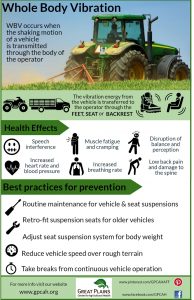
Click the photo above to download the poster on what Whole Body Vibration is and how it affects your health
How to Use in Class
- Discuss how maintaining equipment helps not only good farming but can lead to improved health
- In driving instruction classes, talk about the trade-off of speed and whole body vibration
Additional Resources
- Musculoskeletal pain among Midwest farmers and associations with agricultural activities: https://www.ncbi.nlm.nih.gov/pubmed/25345841
- Information on the study: http://www.public-health.uiowa.edu/gpcah/center-projects/musculoskeletal-symptoms-among-farmers/

